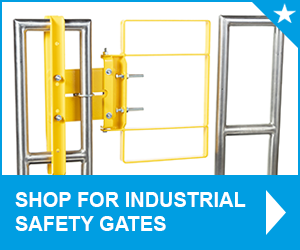
Employers must provide fall protection to each employee exposed to falls in the course of their work duties. All fall protection systems must meet OSHA standards to both minimize the risk of injuries to employees from falling and falling objects, and to protect the organization from OSHA fines and other costs.
Metal swing gates, used in concert with guardrails, are among the most popular ways of protecting workers due to their strength and longevity. This article answers all the questions you may have about swing safety gates so you can minimize the risk of falls and falling objects in your facility.
What are Swinging Safety Gates?
Swing gates are gates that open when pushed and automatically close when released. They are also referred to as self closing gates. Industrial self closing safety swing gates are designed to work with guardrails to offer passive fall protection in line with OSHA standards. They can be single- or double-door safety gates.
Does OSHA Require Self Closing Safety Gates?
OSHA does not specify the type or model of safety gates and other fall protection equipment to use. You must make your assessment and consult with safety professionals on what model or type of gates are best for you.
However, according to OSHA 1910.29 (b), if you use guardrail systems to protect users from falls or falling objects around holes that serve as access points (such as ladderways), the opening of the system must have “a self closing gate that slides or of swings away from the hole.”
Why Install Swinging Safety Gates?
The alternative to self closing safety swing gates are manual safety gates, which require a user to physically close the gate after each use.
Though overlookable, the way manual safety gates must be physically closed makes them less safe than self-closing safety gates. If the worker forgets or can’t close the safety gate, it poses a risk to themselves or the next worker. Automatically closing when released (like with swinging safety gates) allows near-endless indoor fall protection, ensuring employees working on ladders, workways, mezzanines, and other elevated areas are fully protected from the risk of falls.
Where are Self Closing Safety Gates Used?
Swinging safety gates are incredibly versatile. You can use them on ground or elevated levels in several applications, such as:
- Ladder and stairway entrances
- Loading docks in industrial facilities
- Uneven floor levels
- Restricted areas, such as those with mechanical or chemical hazards
- Rooftops
- Walk areas
- Ladder ways
They are among the most effective ways of protecting employees from any falls.
Should You Install Swinging Safety Gates in Your Facility?
To determine whether installing self closing gates is the right decision for your facility, consult a qualified individual. They will inspect your facility and determine whether you need a swinging gate or another form of fall protection.
What OSHA Requirements do Swinging Safety Gates have to Meet?
Swinging safety gates must meet the same requirements as safety railings and guardrail systems. You must ensure they meet the following criteria according to OSHA 1910.29.
- The height of the top rails are 42 inches (plus or minus 3 inches) above the walking-working surface.
- They can withstand at least 200 pounds applied in a downward or outward direction within 2 inches of the top edge at any point along the top rail.
- When the 200-pound test load is applied in a downward direction, the top rail of the guardrail system must not deflect to a height of less than 39 inches (99 cm) above the walking-working surface.
- Midrails, screens, mesh, intermediate vertical members, solid panels, and other equivalent intermediate members can withstand a force of at least 150 pounds applied in any downward or outward direction at any point along the intermediate member.
- They are smooth-surfaced to protect employees from punctures or lacerations and to prevent catching or snagging of clothing.
- Steel banding and plastic banding are not used for top rails or midrails.
What is the Best Material for Self Closing Safety Gates?
Self closing safety swing gates come in different materials, such as plastics, polyurethane, and metals. The best material for most applications and work environments is metals, such as galvanized steel, aluminum, carbon steel, stainless steel, etc.
Metal swing gates are strong enough to meet OSHA requirements, are durable so they won’t wear out, are versatile enough to be used for outdoor and indoor fall protection and require very little maintenance to remain OSHA-compliant.
What is the Best Metal Material for Swing Safety Gates?
The best metal material for metal swing gates depends on the application. For example, because stainless steel has good bacteria resistance, it is perfect for organizations that deal with food, beverages, and medical supplies. You should consult a professional to determine the best metal for different swing gate applications in your organization.
Must Swing Gates be Yellow?
No, they don’t. The main reason many are painted in yellow is that it is a bright, highly visible color that enables them to stand out. OSHA guidelines don’t specify the color. You can choose any color and finish to match your organization’s brand, such as powder coating, polished metal finish, or baked enamel.
Where Can I Get OSHA-Compliant Swing Gates?
If you want to install OSHA-compliant self closing safety gates, you should purchase them from an experienced, reputable manufacturer. They can use their experience to guide you, and you can find the best swing gate for your application.
Protect your Business and Workers with Fabenco
Fabenco is a leading manufacturer of adjustable, self-closing industrial safety gates. Our full range of standard carbon steel, stainless steel, and aluminum gates follow OSHA guidelines and can meet any workplace environment. We also develop custom safety gates for organizations with special requirements.
Contact our fall safety experts today to learn more about OSHA-compliant self-closing gates.





